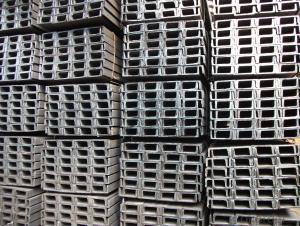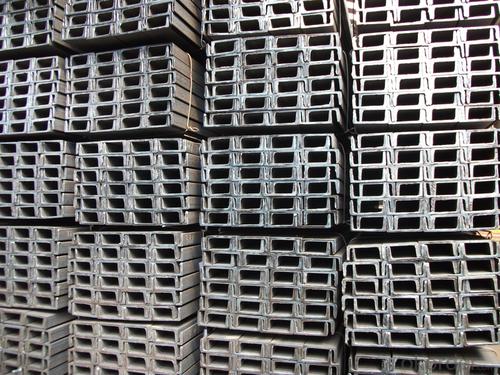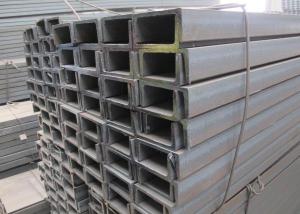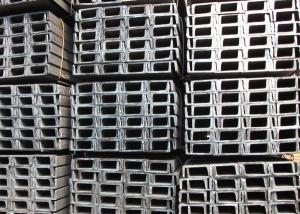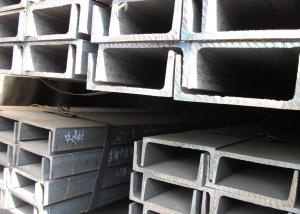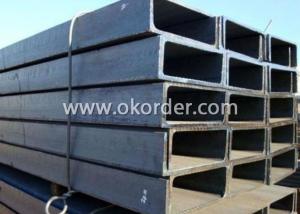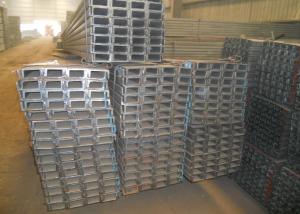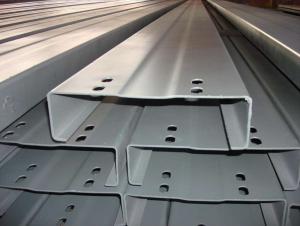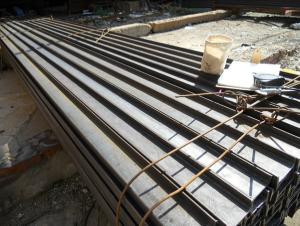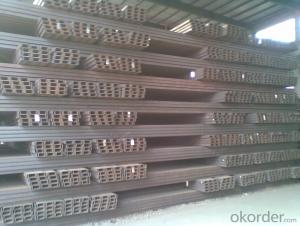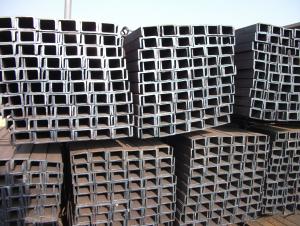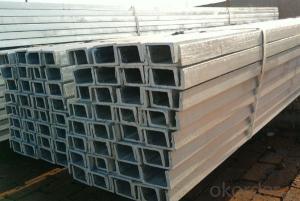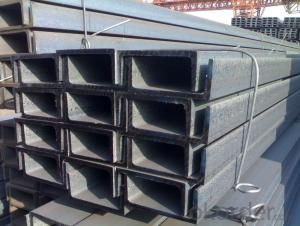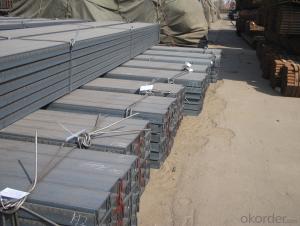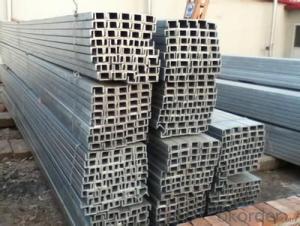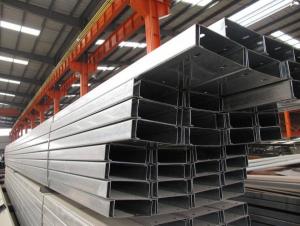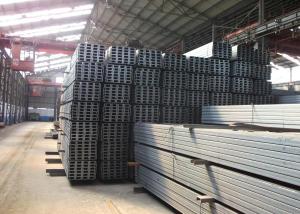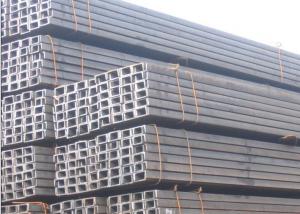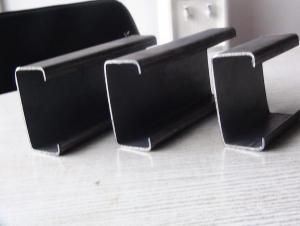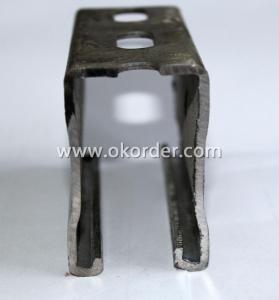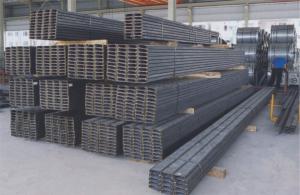Hot Rpled JIS Standard Steel U-channel SS400
- Loading Port:
- China Main Port
- Payment Terms:
- TT or LC
- Min Order Qty:
- -
- Supply Capability:
- -
OKorder Service Pledge
OKorder Financial Service
You Might Also Like
Product Description:
OKorder is offering STEEL CHANNEL at great prices with worldwide shipping. Our supplier is a world-class manufacturer of steel, with our products utilized the world over. OKorder annually supplies products to European, North American and Asian markets. We provide quotations within 24 hours of receiving an inquiry and guarantee competitive prices.
Product Applications:
1.The JIS channel can be devided into two kinds, namely common channel steel and light channel steel. The sizes of hot rolled common channel steel range from 5# to 40#. Meanwhile, the channel steel can be divided into cold forming sectional equal channel steel, cold forming sectional unequal channel steel, cold forming inner edge channel steel and outer edge channel steel.
2.The JIS channel is usually used for arch-itechtural structure, and they could be welded in order to support or hang a vari-ety of facilities. They are also usually used in combination with I beam. The channel steel with sizes under 14# is usually applied to construction engineering, as purline, while the channel steel with sizes above 16# is more likely to be used in building vehicle chassis structure and mechanical structure. Furthermore, the channel steel in sizes above 30# are target at building bridge structure, as tension bar.
3.In a word, the channel steel must possess perfect welding property, riveting property and mechanical property and so on.
Product Advantages:
OKorder's STEEL CHANNELare durable, strong, and resist corrosion.
Main Product Features:
· Premium quality
· Prompt delivery & seaworthy packing (30 days after receiving deposit)
· Corrosion resistance
· Can be recycled and reused
· Mill test certification
· Professional Service
· Competitive pricing
Product Specifications:
Minimum Order Quantity: 25 Tons Unit: m.t. Loading Port: Xingang Port
Supply Ability: 1000 Tons Per Day Payment Terms: TT or L/C
Product Description:
Specifications of Steel U Channel:
Standard Applied: GB Standard, EN Standard(UPN), JIS Standard
Sizes: 50mm to 300mm
Material Grade: Q235B, Q345B, S235JR, SS400, ASTM A36
Production Flow of JIS Channel:
1.The steel billet shall be heated in the high temperature furnace.
2. The heated steel billet shall be rolled five to nine times with the aim of shaping the general figure of steel u channel.
3. The rolled steel channel should be put onto the cooling bed to make the temperature low.
4. The JIS Channel should be straighted on the straightener.
5. The straighted steel u channel will be cut into meters by saw, as per customer's requirements.
6. At the last part of production, the channel steel must be tested in order to confirm that the finished products are completely free from crack, pore, slag, scab or fold on the surface.
Package & Delivery: Steel U Channel
The steel u channel will be packed in bundle with steel wire at each end of every bundle and color marking in order to help the customer to recognize his goods more easily at sight.
And steel u channel could be loaded into 20ft or 40ft container, or by bulk cargo. If the weight of each bundle reaches less than 3.5 mt, the loading by break bulk cargo should be choosed. When the weight of each bundle reaches less than 3mt, the loading by container should be choosed.
As for the transportaion from mill to loading port, the truck will be usually used. And the maximum quantity for each truck is 40mt.
All in all, we could do in accordance with customer's request
FAQ:
Q1: Why buy Materials & Equipment from OKorder.com?
A1: All products offered byOKorder.com are carefully selected from China's most reliable manufacturing enterprises. Through its ISO certifications, OKorder.com adheres to the highest standards and a commitment to supply chain safety and customer satisfaction.
Q2: How do we guarantee the quality of our products?
A2: We have established an advanced quality management system which conducts strict quality tests at every step, from raw materials to the final product. At the same time, we provide extensive follow-up service assurances as required.
Q3: How soon can we receive the product after purchase?
A3: Within three days of placing an order, we will begin production. The specific shipping date is dependent upon international and government factors, but is typically 7 to 10 workdays.
Grade | Yield Strength,N/mm² | Extension Strength N/mm² | |||
Thickness of Steel,mm | |||||
≦16 | >16-≦40 | >40-≦100 | >100 | ||
SS330 | ≧205 | ≧195 | ≧175 | ≧165 | 330-430 |
SS400 | ≧245 | ≧235 | ≧215 | ≧205 | 400-510 |
SS490 | ≧285 | ≧275 | ≧255 | ≧245 | 490-610 |
SS540 | ≧400 | ≧390 | - | - | ≧540 |
Grade | Element(%) | |||
C | Mn | P | S | |
SS330 | -- | -- | ≦0.050 | ≦0.050 |
SS400 | ||||
SS490 | ||||
SS540 | ≦0.30 | ≦1.60 | ≦0.040 | ≦0.040 |
Images:
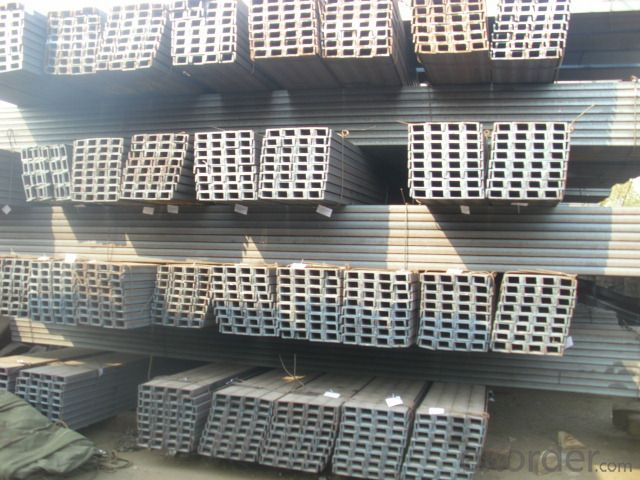
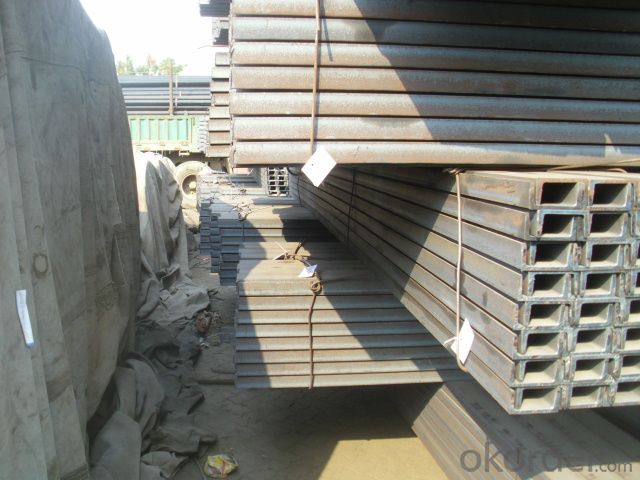
- Q: What are the different surface protection techniques for steel channels?
- To prevent corrosion and enhance the durability of steel channels, there are several surface protection techniques available. These techniques are as follows: 1. Galvanization: Applying a protective zinc coating to the steel channel serves as a sacrificial anode, creating a barrier against corrosion. Galvanized steel channels are highly resistant to rust and can withstand harsh environmental conditions. 2. Powder coating: The application of a dry powder to the steel channel, followed by heating, creates a durable and protective finish. This technique provides excellent resistance against corrosion, chemicals, and UV rays, while also offering a wide range of color options. 3. Epoxy coating: Epoxy coatings are suitable for steel channels exposed to chemicals or harsh environments. By applying a layer of epoxy resin, a protective barrier forms against corrosion, abrasion, and impact. 4. Paint coatings: Painting the steel channel with a layer of paint is a cost-effective surface protection method. The paint acts as a barrier, preventing moisture and oxygen from reaching the metal surface, thus reducing the risk of corrosion. Depending on specific requirements, different types of paints, such as acrylic, enamel, or epoxy, can be used. 5. Stainless steel cladding: This method involves covering the steel channel with a layer of stainless steel. Stainless steel is highly resistant to rust and oxidation, providing excellent corrosion resistance. Additionally, it offers a visually appealing and durable finish. 6. Hot-dip coating: Immersing the steel channel in a bath of molten zinc creates a thick and uniform zinc coating. This technique provides exceptional protection against corrosion and is commonly used in outdoor applications where the steel channel may be exposed to moisture, chemicals, or extreme temperatures. Each of these surface protection techniques has its own advantages and suitability for specific applications. The choice of technique depends on factors such as the environment, desired aesthetics, durability requirements, and budget considerations.
- Q: What are the weight calculations for steel channels?
- The weight calculations for steel channels depend on the dimensions and type of channel being used. To calculate the weight of a steel channel, you would typically multiply the cross-sectional area of the channel by the density of steel. The cross-sectional area can be calculated using the height, width, and thickness of the channel. It is important to consult engineering references or use specialized software to accurately determine the weight of steel channels based on their specific dimensions and specifications.
- Q: If the welding position is rusty, does it affect the life span? After all, the place of welding is thinner than the channel itself. If it is thick, it will not be afraid. The package is in the shed. How do you handle it?,
- Rust is a common phenomenon, it is a complex process. The rust is process of metal and oxygen in the air, carbon dioxide and water vapor phase. There are many factors affecting metal rust in general, the more pure metal is not easy to rust. Ordinary iron, a rust and moist air. A piece of pure iron is drown in the water a few years or a bit. I am still my old self., not rust. Processing methods have effect on rust. A piece of iron into a crack, then beaten, although no crease, but crease place is easy to rust. The smooth degree of metal the surface rust and also has a relationship, is not easy to rust surface more smooth, more rough, more easy to rust. The metal met local overheating or beat produce thermal stress and mechanical stress of the parts, rusty faster some.
- Q: What are the tolerance limits for steel channels?
- Various factors, including the manufacturing process, the specific type of steel channel, and industry standards, influence the tolerance limits for steel channels. Tolerance limits, generally speaking, indicate the allowable deviation from the specified dimensions or properties of the channels. Regarding dimensions, tolerance limits encompass the acceptable ranges for the channel's width, height, and thickness. These limits guarantee that the channels meet the necessary specifications and can be effectively applied in diverse scenarios. For instance, the tolerance limits for the width of a steel channel may be ±0.005 inches, indicating that the actual width can vary within this range. Furthermore, tolerance limits may also encompass other properties of steel channels, such as straightness, squareness, and surface finish. Straightness tolerance ensures that the channel does not exceed acceptable limits for bending or warping. Squareness tolerance ensures that the channel's corners are perpendicular to each other. Surface finish tolerance pertains to the smoothness and quality of the channel's surface. It is crucial to note that specific tolerance requirements may differ among industries and applications. For example, tolerance limits for channels utilized in structural engineering and construction may diverge from those used in manufacturing or fabrication processes. Determining the precise tolerance limits for steel channels necessitates referencing industry standards and specifications offered by organizations like the American Society for Testing and Materials (ASTM) or the International Organization for Standardization (ISO). These standards outline the acceptable tolerance limits for various dimensions and properties of steel channels, ensuring uniformity and excellence in their production and utilization.
- Q: Can steel channels be painted or coated?
- Steel channels have the ability to be painted or coated. The act of painting or coating steel channels has multiple purposes, which include improving their visual appeal, shielding them from corrosion, and increasing their durability. Prior to the painting or coating process, it is necessary to adequately prepare the channels by cleaning them, removing grease, and eliminating any rust or impurities. Once the preparation is complete, various methods can be employed to paint the channels, including brushing, spraying, or dipping. Coatings can also be administered through procedures such as electroplating or hot-dip galvanizing. The selection of paint or coating is dependent on specific requirements and desired outcomes, such as anti-corrosion properties, resistance to weather conditions, or fire resistance. In conclusion, painting or coating steel channels is a widely practiced and effective technique to enhance their appearance and extend their lifespan.
- Q: Can steel channels be used for mezzanine floors?
- Yes, steel channels can be used for mezzanine floors. Steel channels are commonly used in construction for their strength and durability. They can be used as the primary structural support for mezzanine floors, providing a sturdy framework for the elevated platform. Steel channels can be easily fabricated and installed, making them a practical choice for mezzanine floor construction. Additionally, steel channels can withstand heavy loads and provide sufficient support for various activities such as storage, offices, or additional workspaces. Overall, steel channels are a suitable and commonly used material for constructing mezzanine floors.
- Q: How are steel channels connected to other structural members?
- Steel channels can be connected to other structural members through various methods such as welding, bolting, or using mechanical connectors. This ensures a secure and stable connection between the steel channels and the other structural components, enabling them to function together as a unified system.
- Q: How do steel channels contribute to the durability of a structure?
- Steel channels contribute to the durability of a structure in several ways. Firstly, steel channels are made from a high-strength material which provides excellent resistance to external forces. This means that they can withstand heavy loads, impacts, and vibrations without deforming or breaking, ensuring the structural integrity of the building. Secondly, steel channels are designed with specific shapes and dimensions, allowing them to distribute the loads evenly across the structure. This helps in preventing localized stress concentrations, reducing the risk of fatigue failure over time. By evenly distributing the forces, steel channels can also minimize the potential for cracks or structural deformations, enhancing the long-term durability of the structure. Furthermore, steel channels offer superior corrosion resistance compared to other materials like wood or concrete. Steel is often protected with coatings or galvanized to prevent rust and corrosion, which can significantly extend the lifespan of the structure. This resistance to corrosion is particularly important in environments with high humidity, exposure to saltwater, or industrial pollutants. Another advantage of steel channels is their versatility and adaptability in construction. They can be easily fabricated and customized to fit the specific needs of a structure, including size, shape, and connection details. This flexibility allows for efficient construction and the ability to modify or expand the structure in the future without compromising its overall durability. Lastly, steel channels offer fire resistance, which is crucial for the safety and durability of a structure. Steel has a high melting point and does not contribute to the spread of fire, providing valuable time for occupants to evacuate and minimizing damage to the building. This fire resistance also reduces the need for extensive fireproofing measures, making steel channels a cost-effective solution for enhancing the durability of a structure. In summary, steel channels contribute to the durability of a structure by providing high-strength, even load distribution, corrosion resistance, versatility, and fire resistance. These qualities help ensure the longevity and safety of the building, making steel channels a valuable component in construction.
- Q: How are steel channels installed?
- Steel channels are typically installed by following a series of steps. The first step is to determine the appropriate location and layout for the channels. This involves measuring and marking the positions where the channels will be installed. Once the layout is determined, the next step is to prepare the area for installation. This may involve clearing any debris or obstructions, ensuring a level surface, and making any necessary adjustments. The steel channels are then positioned in the designated locations. This is typically done by using a crane or other lifting equipment to carefully place the channels into position. It is important to ensure that the channels are properly aligned and level during installation. After the channels are in place, they are secured using various methods. This may involve welding, bolting, or other fastening techniques, depending on the specific requirements and design of the installation. Finally, once the channels are securely installed, any necessary finishing touches can be made. This may include painting, applying protective coatings, or making any necessary adjustments to ensure proper functionality. Overall, the installation of steel channels requires careful planning, precise measurements, and proper securing techniques to ensure a safe and effective installation. It is important to follow industry standards and guidelines to ensure the channels are installed correctly and will perform as intended.
- Q: Can steel channels be used for signage structures?
- Signage structures can indeed utilize steel channels. These channels possess great strength and durability, rendering them appropriate for supporting hefty signage. It is also simple to fabricate and tailor them to meet specific design needs. What's more, steel channels can endure diverse weather conditions, such as strong winds and heavy rain, guaranteeing the longevity of the signage structure. Furthermore, they can be powder coated or painted to achieve the desired aesthetic, resulting in a professional and visually captivating appearance. In general, due to their strength, durability, and versatility, steel channels are widely trusted and favored when it comes to signage structures.
Send your message to us
Hot Rpled JIS Standard Steel U-channel SS400
- Loading Port:
- China Main Port
- Payment Terms:
- TT or LC
- Min Order Qty:
- -
- Supply Capability:
- -
OKorder Service Pledge
OKorder Financial Service
Similar products
Hot products
Hot Searches
Related keywords
